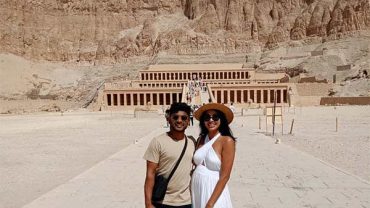Nestled in the heart of historic Cairo, the Mosque of Ahmad Ibn Tulun stands as a testament to the rich tapestry of Islamic art and culture. This architectural masterpiece, built in the 9th century, showcases the enduring legacy of Islamic civilization.
The mosque is not merely a place of worship; it is a living symbol of the cultural and intellectual flourishing that marked the Islamic Golden Age. In this article, we will delve into the historical significance, architectural brilliance, and cultural impact of the Mosque of Ahmad Ibn Tulun, exploring how it continues to captivate visitors with its timeless allure.
Historical Context
The Mosque of Ahmad Ibn Tulun, commissioned by the Abbasid governor Ahmad Ibn Tulun in 876 AD, represents a pivotal era in Islamic history. It was constructed during the Tulunid dynasty, a time marked by political stability and cultural efflorescence. The mosque was designed by the talented Syrian architect, Muhammad ibn Katib al-Farghani, and its construction employed innovative engineering techniques that have stood the test of time.
The choice of the location, surrounded by an open courtyard, reflects a departure from traditional mosque architecture and exemplifies the forward-thinking approach of the builders.
This historical period was characterized by a flourishing of arts, sciences, and philosophy within the Islamic world. The Mosque of Ahmad Ibn Tulun thus becomes a tangible relic, offering a glimpse into the intellectual and cultural milieu of a bygone era. Its preservation over the centuries is a testament to the reverence it has garnered as a cultural and religious landmark.
Architectural Marvel
The architectural brilliance of the Mosque of Ahmad Ibn Tulun lies in its simplicity, symmetry, and attention to detail. The central courtyard, one of the largest in the Islamic world, is flanked by graceful arcades and surrounded by an elegant minaret. The mosque’s layout, with a vast open space and a single large dome, showcases a departure from earlier architectural norms. The unique spiral minaret, reminiscent of ancient Egyptian obelisks, stands as an iconic feature, adding to the mosque’s distinctive silhouette.
The use of carved stucco, intricate geometric patterns, and calligraphic inscriptions on the mosque’s walls exemplifies the mastery of Islamic decorative arts during this period. The stark contrast between the red bricks and white stucco creates a visually striking effect, enhancing the overall aesthetic appeal of the mosque. The architectural innovations seen in the Mosque of Ahmad Ibn Tulun have influenced subsequent Islamic architectural styles, leaving an indelible mark on the development of mosque design.
Cultural Impact
Beyond its architectural significance, the Mosque of Ahmad Ibn Tulun has played a vital role in shaping the cultural identity of Cairo and the broader Islamic world. As a place of worship, it continues to serve its original function, welcoming Muslims for prayer and reflection. Additionally, the mosque has become a focal point for cultural events, educational programs, and scholarly discussions, fostering a sense of community and intellectual exchange.
The mosque’s cultural impact extends beyond the realm of religious activities. Its open courtyards and shaded arcades have provided a space for social gatherings, fostering a sense of unity among diverse communities. The ongoing preservation efforts and meticulous restoration work ensure that future generations can continue to appreciate and learn from this cultural gem, reinforcing its role as a bridge between the past and the present.
Religious Significance
The Mosque of Ahmad Ibn Tulun not only represents a marvel of architecture but also holds profound religious significance for the Muslim community. Serving as a place of worship for over a millennium, the mosque has been a spiritual anchor for countless individuals. Its tranquil courtyards and prayer halls create an atmosphere of serenity and devotion, inviting worshippers to engage in prayer and contemplation.
The mosque’s historical association with the Tulunid dynasty adds another layer of religious importance. The patronage of a prominent Islamic figure like Ahmad Ibn Tulun underscores the mosque’s role not only as a religious institution but also as a symbol of political and spiritual authority. The spiritual resonance of the Mosque of Ahmad Ibn Tulun is palpable, making it a revered destination for pilgrims and visitors seeking a connection to Islamic history and heritage.
Preservation Challenges and Initiatives
While the Mosque of Ahmad Ibn Tulun has endured for centuries, it has not been immune to the challenges posed by time, climate, and urban development. Preservation efforts have become crucial to ensure the continued integrity of this architectural gem. Conservationists and historians have faced the delicate task of maintaining the mosque’s authenticity while implementing necessary repairs and renovations.
Ongoing initiatives focus on structural stability, the restoration of decorative elements, and the safeguarding of historical inscriptions. The delicate balance between preservation and modernization reflects a commitment to honoring the mosque’s heritage while adapting to contemporary needs. International collaborations, local community involvement, and advancements in conservation technology contribute to the ongoing success of these preservation endeavors.
Visitor Experience and Educational Outreach
The Mosque of Ahmad Ibn Tulun welcomes visitors from around the world, offering them not only a glimpse into the past but also an opportunity for cultural exchange and understanding. Educational programs and guided tours provide insights into the mosque’s history, architecture, and cultural significance. These initiatives aim to foster a deeper appreciation for Islamic art and heritage, transcending cultural and religious boundaries.
Visitors can explore the mosque’s intricate details, from the geometric patterns adorning the walls to the panoramic views from the minaret. The mosque’s role as a cultural and educational hub extends to the surrounding community, contributing to a broader understanding of Islamic history and its impact on the development of art and architecture.




Comment (0)